Picking the Perfect Deck Railing: A Detailed Summary
Choosing the Perfect Deck Barrier: A Detailed Summary provides useful insights and guidance for homeowners, engineers, and service providers who are looking for to improve the looks, security, and performance of their exterior spaces. Whether you are looking to upgrade your existing deck or get started on a new building and construction task, this extensive overview will certainly offer as an useful source to aid you choose the perfect deck railing that will certainly complement your outdoor area and stand up to the test of time.
Product Options for Deck Railings
When considering product alternatives for deck railings, it is essential to thoroughly evaluate the sturdiness, aesthetics, and maintenance needs of each alternative. The selection of product for deck barriers plays an important role in the overall functionality and look of the deck. One prominent option is timber, which offers a all-natural and timeless look. Nevertheless, wood barriers need routine maintenance to protect against deteriorating, warping, and fading. Another choice is metal, such as light weight aluminum or steel, which offers longevity and toughness. Steel barriers are resistant to weather, need marginal maintenance, and can be customized to fit different style preferences. Additionally, glass railings have actually gained appeal as a result of their modern and streamlined appearance. While glass barriers need regular cleaning to maintain their transparency, they provide unhampered sights and a contemporary visual. Composite railings made from a mix of timber fibers and plastic offer the appearance of wood without the maintenance. Composite railings are immune to rot, bugs, and fading, making them a low-maintenance option. Ultimately, the choice of deck barrier product must be based upon personal choices, budget, and the preferred style of the deck.
Design and Layout Considerations
To ensure the perfect deck barrier, it is important to thoroughly think about numerous style and layout considerations. The design and design of the deck barrier can greatly affect the overall visual allure of the deck and the whole exterior space.
In addition to the building style, it is vital to consider the general style theme of the deck and outdoor room. The deck railing need to complement the existing layout components, such as the color design, products, and furniture. Integrating these components will certainly produce a cohesive and visually pleasing appearance.
Another essential consideration is the degree of personal privacy and security preferred. Some homeowners may choose a deck railing with strong panels or screens to provide personal privacy from surrounding residential or commercial properties. Others might prioritize safety and go with a barrier with carefully spaced balusters to stop children or pet dogs from squeezing through.

Safety And Security and Structure Code Demands
To make certain conformity with safety and building regulations requirements, it is important to think about various laws and standards when choosing a deck railing. Building ordinance and security laws are established to safeguard individuals and decrease the danger of injuries or mishaps. These codes specify the minimal demands for deck railings, including elevation, spacing between balusters, and load-bearing ability.
The height of a deck barrier is an essential consider making sure safety and security. Many building regulations need a minimum barrier height of 36 inches for property decks and 42 inches for industrial decks. This elevation requirement assists stop gives an obstacle and drops for pet dogs and youngsters.
Another important factor to consider is the spacing in between pickets or balusters. Building regulations usually define an optimum spacing of 4 inches to protect against kids from obtaining stuck or dropping via the gaps. This requirement uses not only to the vertical spacing however likewise to any kind of straight components that might be used as a ladder.
In addition, deck barriers need to have the ability to hold up against a specific quantity of force to make sure structural honesty. Structure codes specify the minimal load-bearing capability for barriers based on elements such as the height of the deck and the expected usage of the room. It is crucial to pick a barrier system that fulfills or exceeds these demands to make sure safety and security and conformity.
Maintenance and Longevity Factors
Thinking about upkeep and toughness is crucial in picking the excellent deck barrier to ensure its long-term efficiency and functionality. A well-maintained deck railing not only improves the general appearances of your outdoor area, yet it also supplies find out here essential safety and security and defense.
Durability is an additional key factor to consider. The durability of a deck barrier depends upon the product used and its resistance to exterior elements such as dampness, severe temperatures, and UV rays. For optimum sturdiness, products like plastic, composite, and metal are outstanding options. These materials are recognized for their toughness, longevity, and ability to stand up to extreme climate condition without wearing away.
Along with product selection, proper installment and regular assessments are necessary for preserving the resilience of your deck railing. On a regular basis examining for any signs of wear, damage, or loose parts allows check these guys out for prompt repairs and makes sure the longevity of the barrier.

Budget Plan and Expense Considerations
When evaluating spending plan and cost factors to consider, it is important to meticulously examine the financial ramifications of your chosen deck barrier products and setup. The expense of deck railing can differ dramatically depending upon various factors such as the material, style complexity, and setup technique.
One of the vital aspects that can impact the budget plan is the material utilized for the deck barrier. Wood barriers are usually the most economical alternative, while metal railings have a tendency to be much more pricey.
In enhancement to the material price, the intricacy of the railing design can also impact the budget. Intricate designs with custom-made elements or ornate details will typically be extra pricey than straightforward, typical layouts.
Furthermore, the technique of installation can impact the total cost. Do it yourself installment can conserve cash, but it calls for time, ability, and proper devices. Hiring a professional for this article setup might incur additional costs but guarantees a top notch and effective installation.
Conclusion
Finally, selecting the suitable deck barrier entails considering various factors such as product choices, style and style considerations, safety and security and building code demands, upkeep and sturdiness factors, as well as spending plan and price considerations. By carefully assessing these aspects, property owners can select a deck railing that not just enhances the aesthetic allure of their outside area yet additionally makes sure security and satisfies their particular demands and preferences.
Whether you are looking to update your existing deck or begin on a brand-new building project, this comprehensive guide will serve as a valuable source to help you choose the perfect deck railing that will certainly complement your outdoor area and endure the test of time.
The choice of material for deck railings plays a critical role in the total performance and look of the deck. Inevitably, the option of deck railing product must be based on individual preferences, budget plan, and the preferred design of the deck.
The design and design of the deck barrier can substantially influence the total visual allure of the deck and the entire outdoor space (Deck Railing). Wood barriers are generally the most economical option, while steel barriers often tend to be more costly